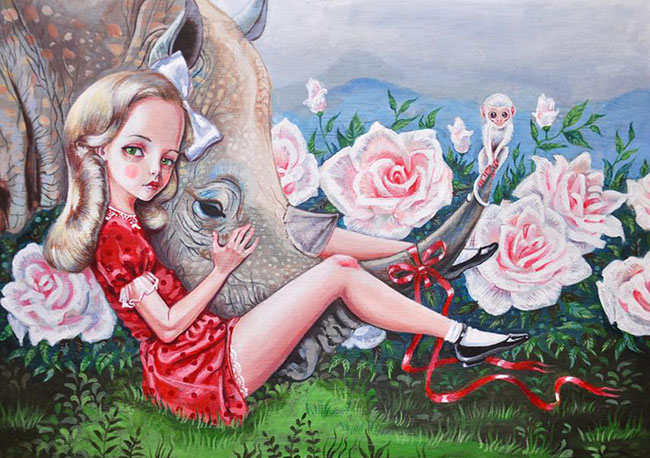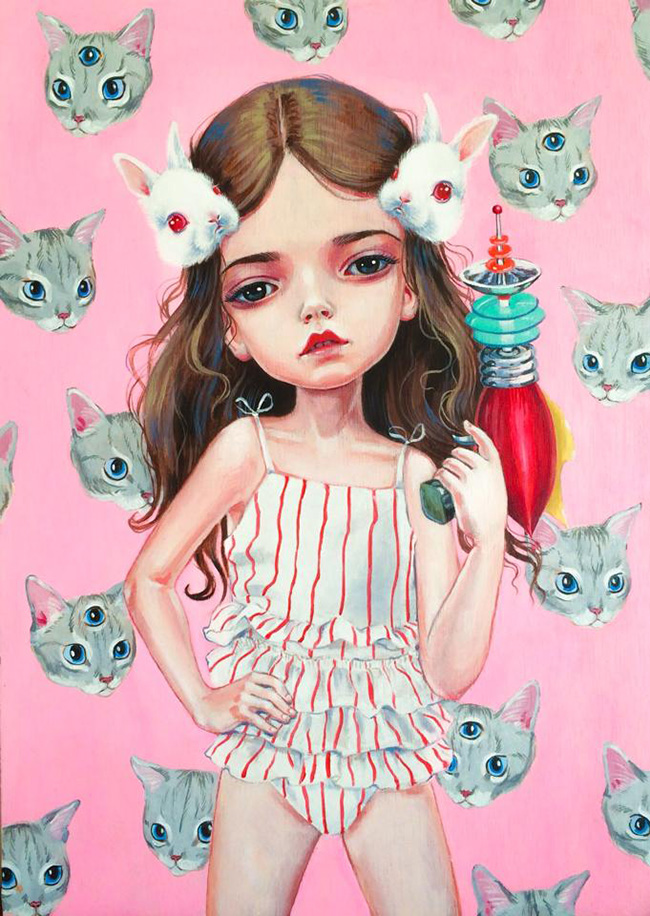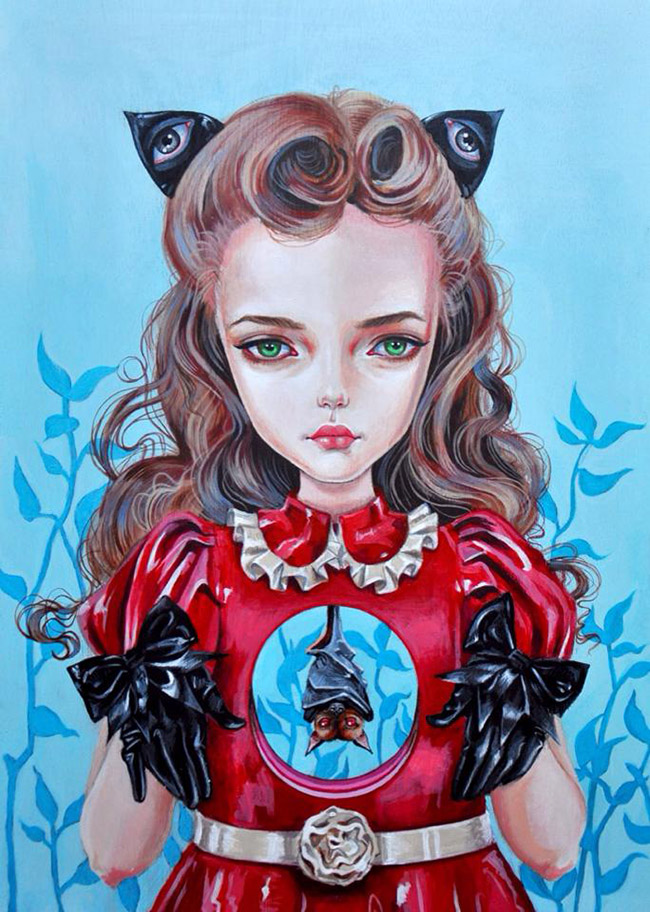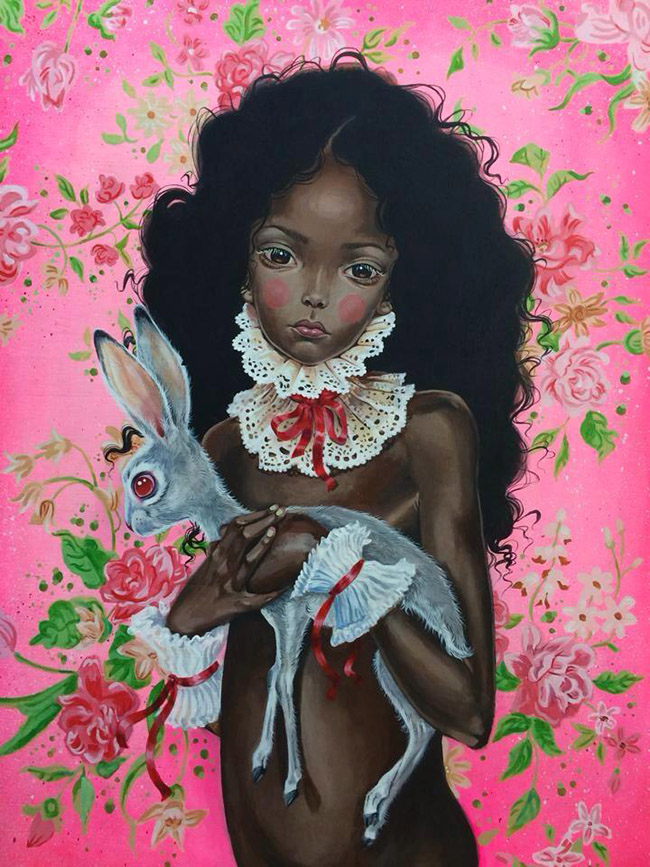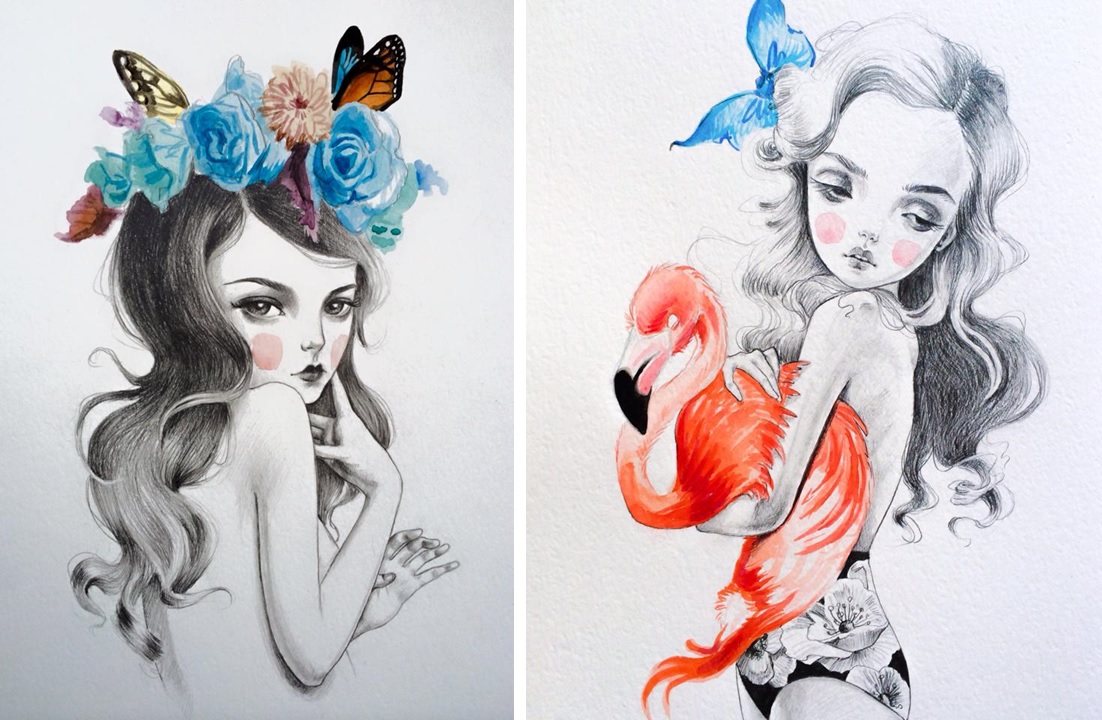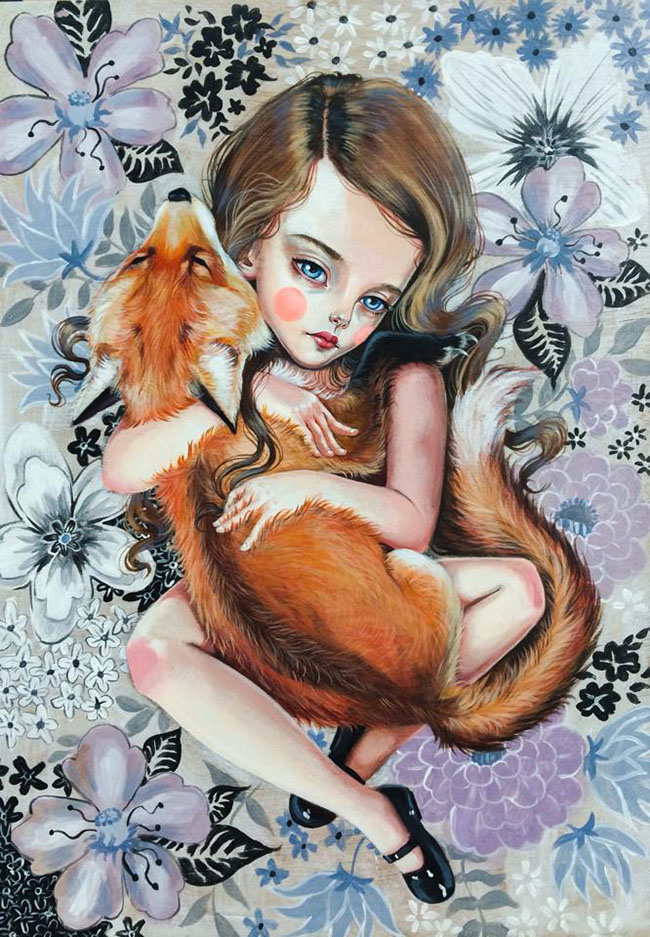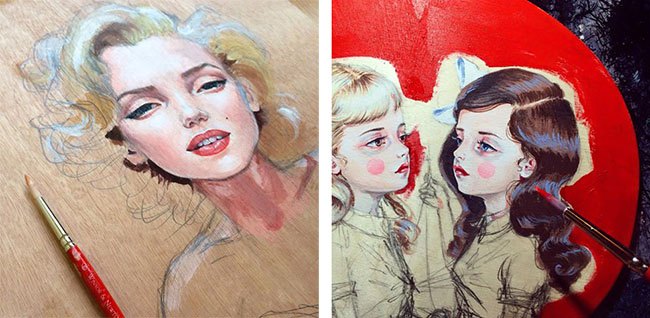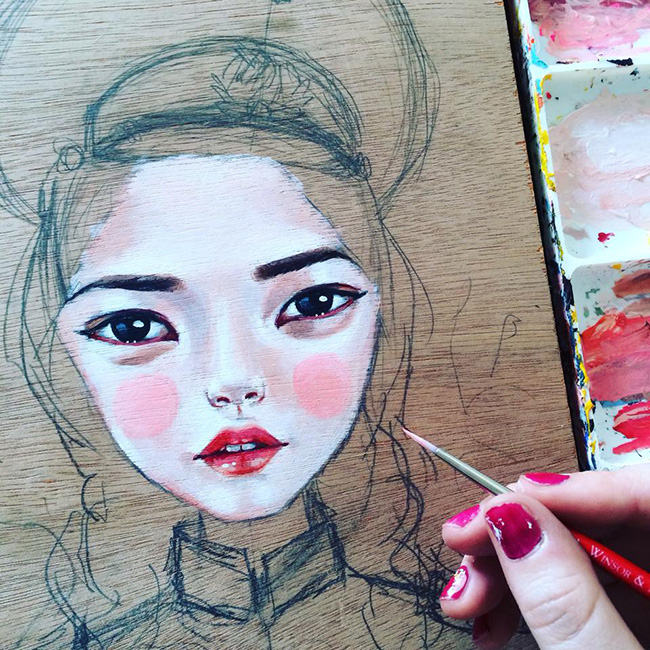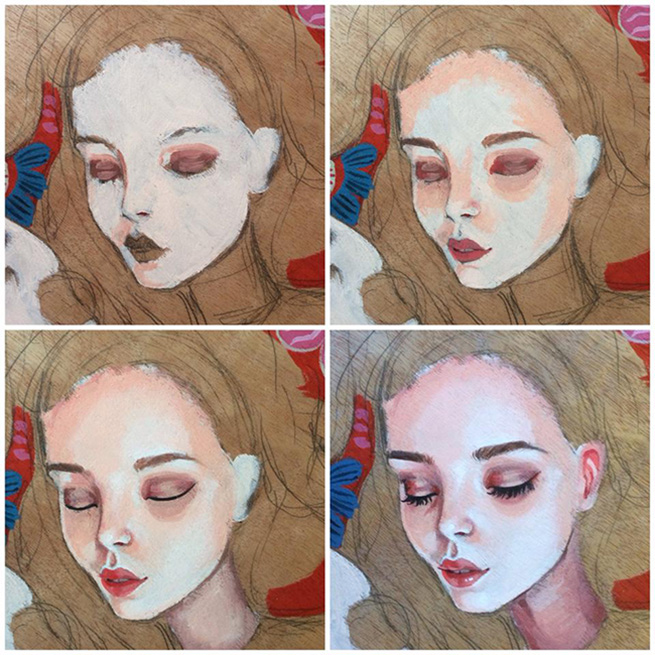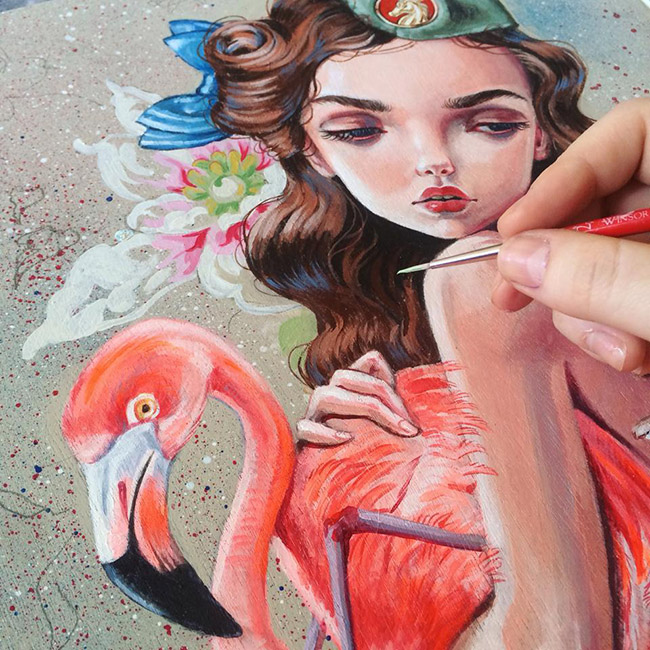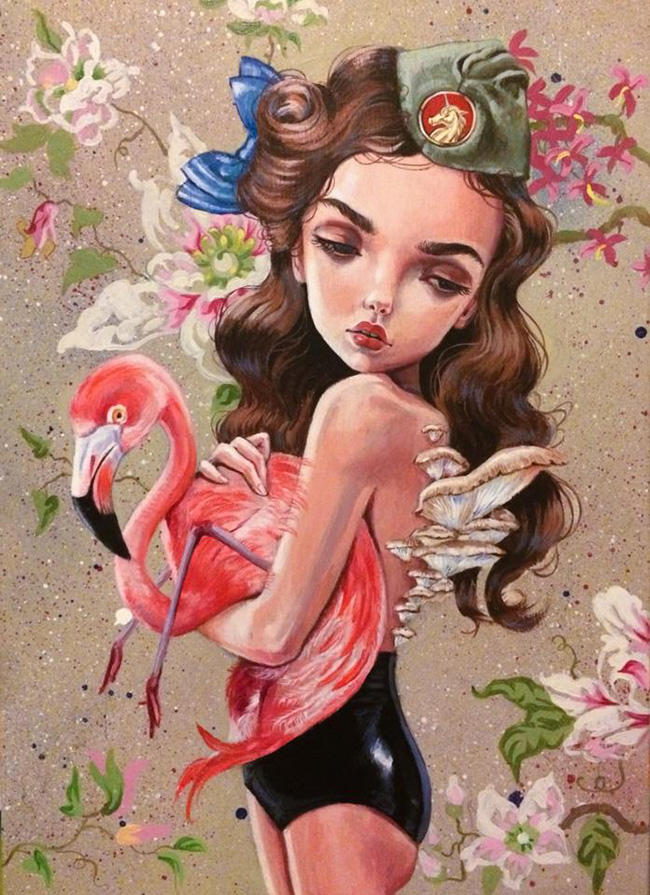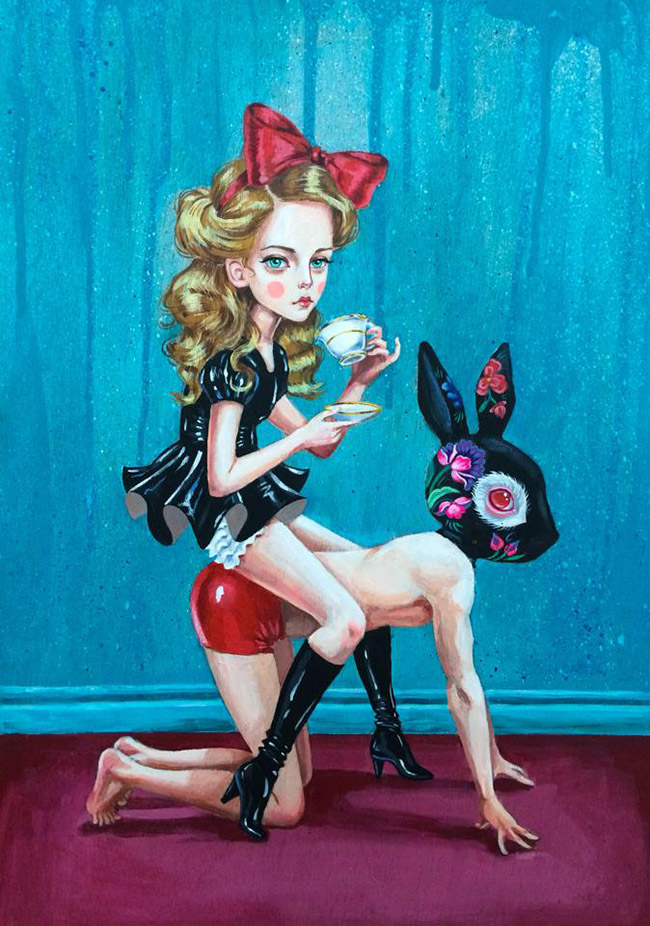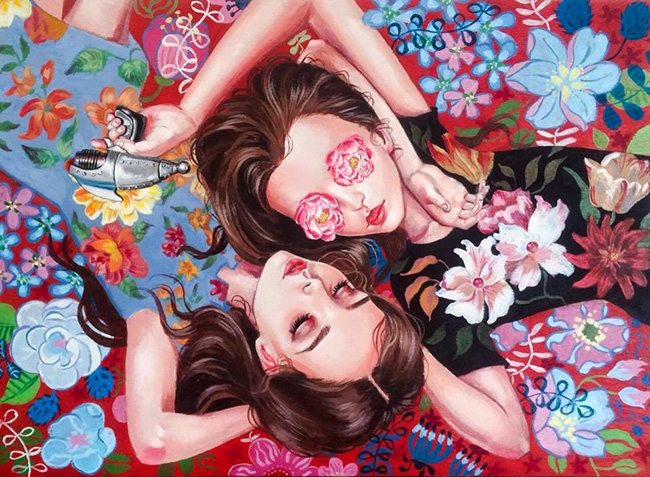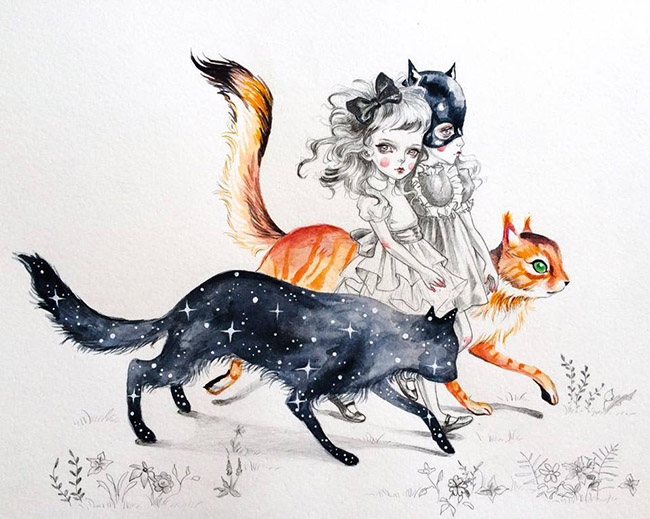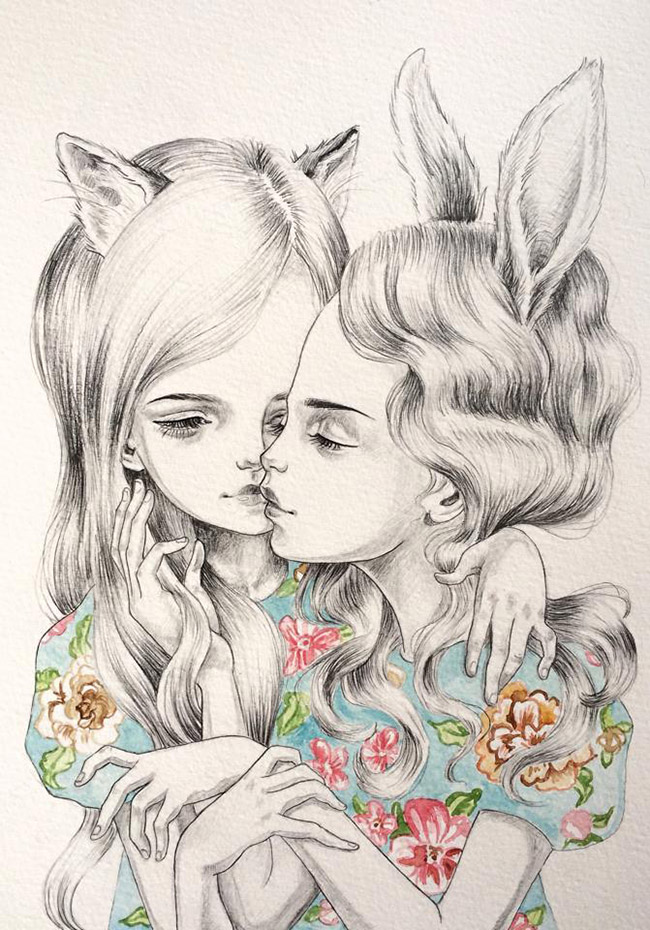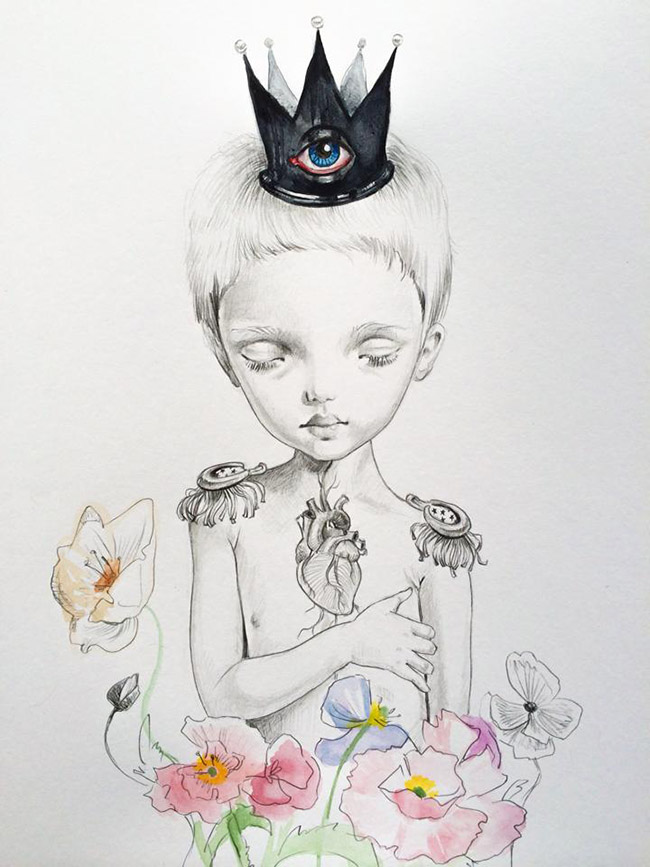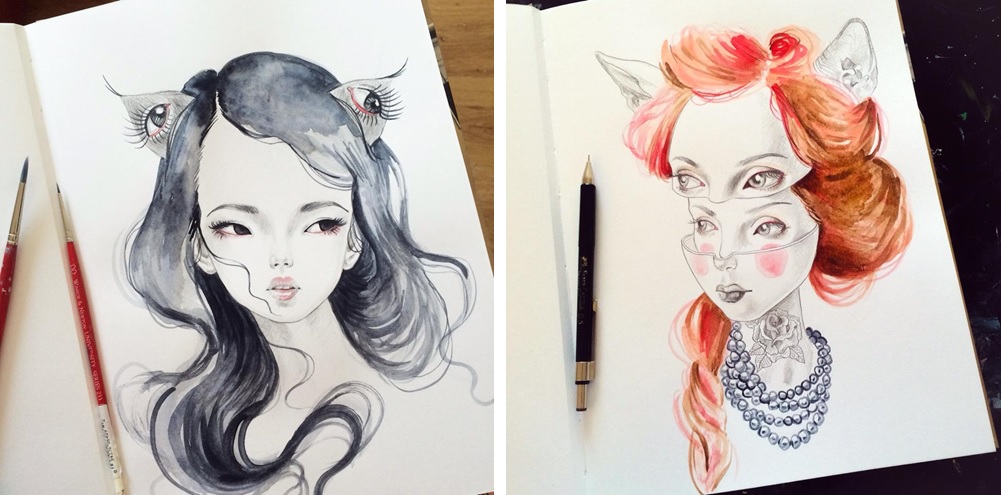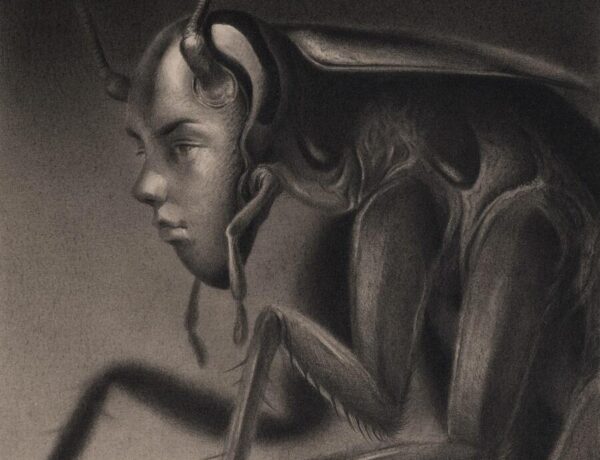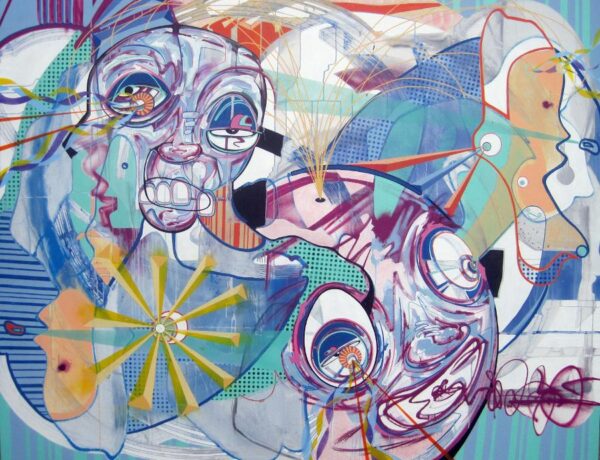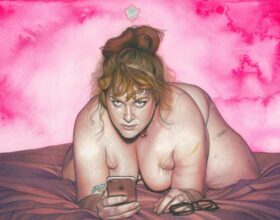Permeated by the same magic that gave birth to mythological tales thousands of years ago, Julie Filipenko ’s animated dolls speak to the crowds with their melancholic eyes and their implicit need for protection. In their attempts to bring to light their own frailty and humanity, Filipenko’s well dressed female characters – sometimes frightened, sometimes overly confident little girls – reveal their own inner beauty, self-appropriation, and strength with their big, penetrating doll-like eyes, perhaps stolen from fashion magazines and TV commercials.
Julie Filipenko’s work will be a part of an upcoming group show curated by Beautiful Bizarre at Modern Eden Gallery in San Francisco, CA. The show is entitled “Femme to Femme Fatal: The Feminine in Contemporary Art”. Opening reception is Saturday, September 17, 6 pm–9 pm and will be on view through Saturday, October 8.
BB: You are from Tel Aviv, which is known not only for its rich history but also for the numerous political conflicts that have taken place here during the past fifty years. In virtue of a strange post-news-media expectation/prejudice, one would expect Israeli artists to use their art mainly to talk about politics in response to the negative media attention they’ve had to face over time. One of the meanings of the words “Tel Aviv” is “hill of spring” and I can see that in your work, perhaps as a refusal of your country’s historical background. How does your work relate to your cultural heritage?
JF: Unlike many other people, I was brought up with no concept of home as a specific place tied to a particular geographical spot. I was raised by parents that were constantly on the move, hopping from city to city and from country to country. I was born in USSR, and from age 5 grew up all over the USA, until moving to Israel when I was 13. As a result, I was exposed to different cultures, traditions, and ways of thinking from a young age. Because of my diverse upbringing, I don’t feel obligated to be connected to any specific place. This sort of experience taught me to adapt to new surroundings, and adapting made me feel free to accept ideas that I like and disregard what doesn’t resonate with me. I grew up as a child whose soul was fed on a mash-up of Russian melancholic 18th century literature, American pop culture, and the Middle Eastern conflict rolled up all in one ball. That’s why I prefer to focus on emotion in my work rather than illusive circumstances. Take my recent solo for example “Honey Trap” which was inspired by the red army. I was careful to make sure none of the works could be interpreted as political. I wanted to discuss the human emotion that was present in that space and time, but that anyone can connect to.
BB: Where does Julie Filipenko come from, not only geographically? How has your education affected the development of your personality and perhaps even “upset your origins,” both intrinsically and conceptually, in a world where national identity says where we come from – and for certain cultures even who we ARE –, whereas in the art world who we are is determined mostly by our individual identity? What has been your path, so far, to find your true self?
JF: I got my bachelor’s degree in fine arts from the Bezalel Academy of Arts and Design. I did not have an easy time at school at first. However, after the first two years I realized that the academy was really helping me broaden my view and have a more objective approach towards art and philosophy. That’s where I learned for the first time that even if I personally disagree or dislike a certain idea/theory/concept, I can still find it interesting and play with it. My school was very pro conceptual art and very anti kitsch. My professors used to say that kitsch is a reflection of the obsolete, hence crossed off most anything that was not abstract art. This made it challenging for us students to form a personal figurative style that we wouldn’t be bashed for in class. As a result, I felt quite lost for some time, and for years after I finished school I couldn’t bring myself to paint anything out of the following constant lingering question: Is this valid? However, there was never a moment when I didn’t obsess over the idea of making art.
BB: How did you get acquainted with what is obviously a mixture of Asian figurative art and American pop/lowbrow art? Who do you take inspiration from?
JF: I was serious bookworm. I would devour any book I could get my hands on in middle school. There was a rule at the library, one book per student at checkout, but the librarian knew me so well that she allowed me to leave with ten books at a time. I read everything, but my favorites were Russian and American classics, gypsy fairy tales, and somehow I got my hands on Japanese and Chinese literature as well. Perhaps it had something to do with my school being in an Asian quarter of town when I was living in San Francisco. It left me with a big impression and the glimpses I got of their psychological process felt close to my personal views at that time. Today I feel like a lot of what I express through my art keeps coming from this well of accumulated impressions from my younger years. Later when I got acquainted with the lowbrow movement, I was stunned. I discovered artists that were creating the type of art that I wanted to create but was afraid, and no one was telling them “No, you’re not allowed to do that.” That inspired me to let go of my fears, and go do things the way I wanted them to be done.
BB: How did you go from doing a “normal job for humans” to becoming a full time artist, showing with some of the top American galleries (or have you just always been an artist)?
JF: Even during the gap between when I got my art degree but wasn’t making any art, it was obvious to me that I was an artist. I didn’t know how to start creating or making a living in that field at first. I did some truly odd jobs to pay the rent until I finally became a manager at a local art gallery in Jerusalem. I had a lot of spare time there, so I started experimenting with drawings during my shifts. The more I drew the more recognition I got on social media. With attention on social media, I started getting offers for my artwork, which made galleries start noticing me and inviting me to show with them, until finally, I felt comfortable enough to switch from a full time job to just a few shifts. Sometime after that, I found myself not needing those shifts anymore because that was very valuable time; I needed to get ready for my art shows.
BB: How do you see yourself, when you think about all the artists and galleries there are in the world? Do you feel big, small, excited, overwhelmed, or what else? How can we locate/individuate/distinguish your work in this sea of visual information where, in a way, everyone is (forced to be) an artist, almost as a matter of survival? What makes you more of an artist than any other creative mind? What makes you different and even special, in the context of what has now become a worldwide fever or creative illness because of which everyone feels entitled to make art?
JF: Unlike the popular understandings on the subject, I don’t think that one person’s success actually has any influence on another person’s success. Success is like health, it doesn’t exist in limited quantities, so just because some already have it, it doesn’t mean that there’s any less of it left for you. This is why I enjoy admiring and looking up to people that made it big. I think any time you bring something personal to the table, no matter how big or small it is, it will get noticed because anything truly personal will always end up being unique.
BB: Let’s talk more in depth about your work. How does the art-making process begin for you, and what’s the difference between your current process and the one you adopted as a teenage artist when you first began delving into illustration and painting?
JF: My painting process begins in my mind. The actual physical part of it is only half of the work. It’s true that I was painting and drawing since grade school, however back then I was mainly focused on the technique itself, and on being able to represent a shape or object thoroughly. In my adolescent mind that’s what being an artist meant (it referred mainly to the ability to recreate peculiar things in a different way). Today it’s more about what I capture of the essence of my subjects versus the illustrating aspects of my art. I think out the painting thoroughly and visualize what I detect as “important details” before I even begin to touch the brush. That’s why I almost never have the need to sketch it out first because by the time I touch the paint I usually know exactly how I’m going to deal with it.
B: Your process is very interesting, and makes me think about great masters of the past such as Leonardo and Michelangelo. Why do you not use any technologies, to create your works (except the social media platforms you adopt for self-promotional purposes and sales)? Do you not think that “contemporary art” as the adjective suggests, should incorporate and reflect the present? Shouldn’t that involve the latest innovations and trends as well?
JF: There is so much going on today. So many people, with different tastes and likes, and there are enough artists to go around to be able to have a choice to what field they want to dedicate themselves to. I think what makes anything interesting is diversity. Digital painting for example is one of the most contemporary and technologically advanced ways to create an image. However, if that were the only tool allowed for painting today it would lose some of its unique appeal. With all the technology taking over in so many basic aspects of our life, anything handmade the old fashioned, “get dirty” way carries a more nostalgic value. Hand produced items have declined in quantity for reasons of capitalistic profit from consumers, where things have to be produced in unthinkable quantities at cheap prices. That is the uniqueness that art offers when it presents itself as something that does not need to be mass produced. What is missing today is the time and space to lovingly make thoughtful works created by touch and imbued with your personal experience in a physical medium.
BB: There’s been an ongoing discussion during the past decade about the future of abstract art, but never too much fire about figurative art, including sculpture and painting. Why is that, in your opinion? Is it because we just love “seeing ourselves out of ourselves,” that is utilizing art as a mirror of our souls – a pretext to investigate and understand the mysteries embedded in the human nature? How does your work fit in this discussion?
JF: Throughout decades, one of art’s greatest appeal and mystique about it is that it’s viewed as a luxury belonging to the elite of our society. Today some of that has changed. Now art can be accessible to any house because you don’t have to own an actual original painting in order to enjoy the image, instead you can get a less expensive print. That’s where the fascination and increased value of abstract and conceptual art comes from. You can’t duplicate conceptual art and stick it into any living room. My artwork touches and connects to some people. I see that as a big gift, so while I have that going on it’s less of my business what a specific group of people decides to say about or call my artwork as long as I get to enjoy doing what I truly love.
BB: Chromatically your works are strident, almost like a symphony of the Devil – a cursed symphony played in an alternate universe where the laws of mortals do not apply – those colors alone could sustain the weight of intricate compositions populated by the most bizarre creatures of the underworld, yet what we end up coming across is a series of well-dressed girls’ portrayed while wandering the mazes of their own theatrical sets and staged lives. Is there anything more to it than a bunch of sometimes confused, sometimes melancholic yet well rendered school girls dragged out of an adult’s child-like dream?
JF: The idea of “well dressed” is used as symbol for a uniform. Just like white collars help identify office workers, little cute dresses identify a dress code for young females. One of the reasons why I’m so fascinated by the image of a young girl is because I see children resembling an alien in a way. Arriving at a never seen before new planet and experiencing everything about it for the first time, the good and the bad, in awe and wonder. The learning process about what it is to be human is life long, and is almost inventively painful in some way or another. Pain is a guide, which helps you learn, and the discomfort that hurts a little every time you stumble across a collision between how you understood or were taught certain things and the realization of how things are. This kind of painful expansion is silent and happens in the privacy of one’s mind. That’s why the emotions I display in my works are quiet and subtle, and far from obvious dramatic expressions.
BB: Two aspects of your work could potentially contribute to one day turning them into historically relevant Works: your attention to the psychology of your characters, and your attention – be it intentional or not – to the inextricable link between art and society. As aware as I am of the instinctual factors that give artists the drive to create the most amazing things, I think you might have purposefully chosen certain subjects to address socio-psychological issues pertaining to human beings’ two-faced masks. Your works from the series “Secret Girls” are a blatant example of this attempt to remind us, in a playful manner, of the tragicomic ambiguity of our identities.
JF: As opposed to a mask, which is usually intended to hide whatever is behind it, I’m talking about the different layers upon of layers of various and sometimes conflicting traits that construct an identity. Each being can have multiple faces and make up one whole body. As a society, we tend to prefer things to be labeled and simple. I think that’s the reason we sometimes feel startled when we stumble upon something that doesn’t fit with its originally assigned place and assume it’s two faced rather than having more than one part.
BB: Have you ever thought about making sculptures or multimedia installations, or even conceptual artworks (that is are you ever going to get out of what is your current “comfort zone?”). What are your plans for the future in this regard?
JF: I see a lot of things left that I still have yet to achieve when it comes to painting. Making installations and sculptures is something that has crossed my mind, however sometimes you have to choose what you want to dedicate yourself to in order to continue to better yourself at it. I constantly search for ways to more accurately bring out the right emotion in my works, so I don’t necessarily see painting as my “comfort zone.” However, I do have an idea for a readymade piece that’s been stuck in my mind for years and is just waiting to be exhibited at the right place and time



